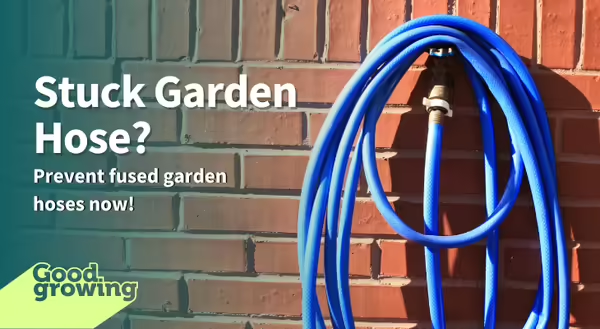
A tale as old as time
I’ve been there. It is late fall and there is a hard freeze about to hit. A wise gardener once warned leaving a hose connected to a spigot during a hard freeze could lead to disaster! As water freezes it expands and any water trapped in the nozzle or spigot could expand to the point it bursts the solid metal or plastic construction of our treasured watering devices. Or worse! Freezing water could creep back into the house and burst a pipe indoors. Now we’re in big trouble!
It happens to me every fall. The sky is a cold cloudy dark swirl, with winds whipping through the landscape that will clear the overcast sky at night letting all that heat escape into the atmosphere, thereby dropping temperatures below freezing. My fingers are nearly numb, as my body, now acclimated to the warmth of summer, struggles to switch into winter mode! Grasping the icy metal hose connection threaded onto the spigot, I twist only to find it will not budge. Over and over again I try, with no luck. The cold turns painful as my hands turn redder by the second.
It’s time to take it up a notch – tools! Pliers to be exact because I can’t find my large Channellock. The biggest set of pliers I own still isn’t quite big enough to grip the hose connected to the spigot. The pliers slip and tear apart the soft aluminum hose connector.
This isn’t working. It’s getting dark and colder. Time to step it up. I ask YouTube. After watching some videos of what NOT to do, I am now terrified I will snap off the spigot with too much force. Maybe I won’t use my ten-pound pipe wrench.
At this point, you may be thinking, “Just take the spray nozzle off the other end and drain out the hose.” That’s a great suggestion, the only thing is my nozzle has been fused to this hose for years. Plus, with the airtight seal at the spigot, there will still be water trapped in there. Back to the spigot connection.
I hit the connection with penetrating oil. Then give it a couple of firm taps with the pliers. Still nothing. Suddenly, my son bursts from the house holding those beautiful blue-handled Channellock pliers! The hose is saved. The tongue and groove pliers create the perfect bite, and allow me to twist carefully, but with more force than the pliers. With a few twists, the hose is off the spigot, but after all that, the fitting is damaged beyond repair. All that work for a ruined hose.
Why Hoses Fuse and How to Prevent It
Why hose connections fuse is based on the metal fitting connectors and water. Most low-cost hoses have aluminum fittings. And most spigots are brass. These are two dissimilar metals that will physically fuse when water is introduced and flows through the point of connection.
In case, you’re reading this in the moment of struggling with a fused garden hose, do an internet search for “galvanic corrosion.” Galvanic corrosion is the name of the chemical reaction taking place between your aluminum and brass fittings and there are some good resources found online using that term. Given enough time the male/female threads could be fused together completely. If it is not budging at all, call a plumber. Applying so much torque that you break the pipe or connection in the wall, may lead to a flooded house.
The moral of the story is? It is summertime, right? And it is dry, which means you are using your hose a lot! It also means it is important to disconnect that hose from the spigot and any watering nozzles to prevent them from fusing.
Or purchase hoses with brass fittings if your spigot is brass. Got a plastic spigot connection? Buy a hose with a plastic fitting. Can’t find these? It’s pretty simple to cut off the end of a hose and replace it with a higher-quality fitting. Most hardware stores have brass fittings (or your material of choice) and hose clamps to fasten them to the cut end.
Our hard freeze may seem like a long way away but remember to disconnect your hose at least once a month so you too don’t wind up outside fighting a fused hose connection.
Good Growing Tip of the Week: For both aluminum and brass fittings you can also lubricate the threads with silicone grease to prevent corrosion and fusing of the fittings.
Signup for our emails!
Want to get notified when new Good Growing posts are available? SIGN ME UP
MEET THE AUTHOR
Chris Enroth is a horticulture educator with University of Illinois Extension, serving Henderson, McDonough, Knox, and Warren counties since 2012. Chris provides horticulture programming with an emphasis on the home gardener, landscape maintenance personnel, and commercial landscapers. Additional responsibilities include coordinating local county Master Gardener and Master Naturalist volunteers - providing their training, continuing education, advanced training, seasonal events, and organizing community outreach programs for horticulture and conservation assistance/education. In his spare time, Chris enjoys the outdoors, lounging in the garden among the flowers (weeds to most).